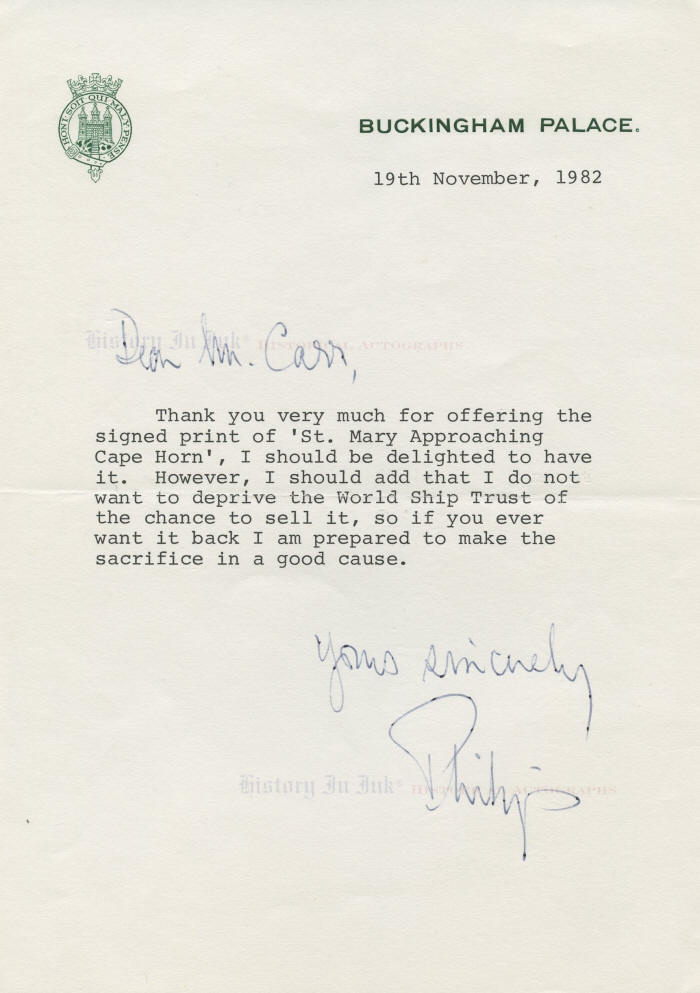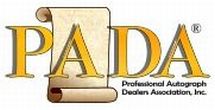2102301
Prince Philip, Duke of Edinburgh
“I should be delighted to have it,” but “if you ever want it back I am prepared to make the sacrifice in a good cause.”
The Prince Philip, Duke of Edinburgh, 1921–2021. Consort of Queen Elizabeth II. Scarce typed letter signed, Yours sincerely Philip, one page, 5¾” x 8¾”, on engraved stationery of Buckingham Palace, [London, England], November 19, 1982.
In our experience, Prince Philip’s letters are very scarce. As a member of the Royal family since 1947 and the husband of the Queen since Elizabeth II acceded to the throne in 1952, one would think that his letters would be more available. But we have had only one other one, and our search of auction records has found only a handful sold since 1975.
In this letter, The Prince thanks Frank Carr, the former director of the British National Maritime Museum, for an art print while nonetheless offering to give it up for charity. Writing to “Dear Mr. Carr,” the salutation in his hand in the British style, he says, in full: “Thank you very much for offering the signed print of ‘St. Mary Approaching Cape Horn’, I should be delighted to have it. However, I should add that I do not want to deprive the World Ship Trust of the chance to sell it, so if you ever want it back I am prepared to make the sacrifice in a good cause.”
Frank George Griffith Carr (1903–1991) directed the National Maritime Museum at Greenwich, England, from 1947 to 1966 and was responsible for restoring a number of ships, including the British clipper ship Cutty Sark. After he retired, he helped to create the Maritime Trust and the World Ship Trust, which Prince Philip mentions in this letter. The World Ship Trust is dedicated to the support for and preservation of historic sailing vessels.
The print to which Prince Philip refers in this letter is of the painting St. Mary Approaching Cape Horn by British maritime artist John Stobart (1929–). It depicts the doomed wooden sailing ship St. Mary on its maiden, and only, voyage. The ship left New York on May 23, 1890, bound for San Francisco on a route around Cape Horn, at the southern tip of South America. Cape Horn is surrounded by wild seas where the Atlantic and Pacific Oceans converge, and thousands of sailors died attempting to sail around the cape. The St. Mary was another of its victims.
The painting depicts the ship as surprised by the passage of a front with squall winds. The St. Mary is shown with billowing sails beneath dark clouds in a tempestuous sea in the vicinity of Cape Horn. The bitterly cold winter wind in the southern hemisphere has ripped the ship’s main upper topsail to shreds, and sailors on the fore upper topsail yard battle to save that sail. The St. Mary collided with the British ship Magellan, which sank with all of its crew. The St. Mary struggled to reach the Falkland Islands but ran aground at night on Pinnacle Rock. Although the St. Mary’s crew reached shore safely in life boats the next morning, the captain refused to leave the ship.
The St. Mary was a Down Easter, a type of ship built in Maine between 1870 and 1900. The Down Easters were the last American effort to participate in world maritime trade by sail. The St. Mary, a 240-foot ship weighing 1941.7 tons, was built at Phippsburg Center, near Bath, Maine. It was launched March 20, 1890, and sailed to New York, from which it departed three days later on its fateful voyage. In 1979, a team from the U.S. National Maritime Historical Society brought a 30-ton section of the St. Mary’s hull back to Maine, where it is on display in the Maine State Museum at Augusta.
Prince Philip was born Prince of Greece and Denmark in Corfu on June 10, 1921. He is the only son of Prince Andrew of Greece, who was the grandson of King Christian IX of Denmark. Prince Philip’s mother was Princess Alice of Battenberg, the eldest child of Prince Louis of Battenberg and a descendant of Queen Victoria. During World War I, Prince Louis, an Admiral of the Fleet and First Sea Lord, Anglicized the Germanic family name “Battenberg” to “Mountbatten.” Philip adopted the family name of Mountbatten when he became a naturalized British subject in 1947.
Lieutenant Philip Mountbatten married Princess Elizabeth, the daughter of King George VI and Queen Elizabeth, in Westminster Abbey on November 20, 1947. Shortly before the wedding, the King created Philip Duke of Edinburgh, Earl of Merioneth, and Baron Greenwich with the style of His Royal Highness and appointed him a Knight of the Order of the Garter.
In 1952, Queen Elizabeth II declared by Royal Warrant that Philip had “place, pre-eminence and precedence” next to her “on all occasions and in all meetings, except where otherwise provided by Act of Parliament.” Five years later she granted him the style and dignity of a Prince of the United Kingdom.
In 1960, the Queen, head of the Royal House of Windsor, declared that those of her descendants not holding royal styles and titles would use the surname Mountbatten-Windsor. In practice, the surname is used by all members of the British royal family descended from the Queen.
This letter is in very fine condition. It is engraved with The Prince’s coat of arms at the upper left. Philip has written the salutation and closing and has signed in blue ballpoint. The letter has one normal mailing fold, which affects a line of the text but none of The Prince’s handwriting or signature, and shows only minor handling.
Unframed.








